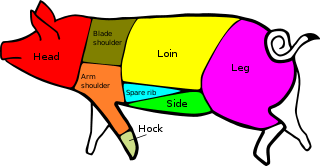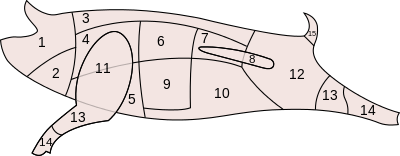Cut of pork
When a pig is butchered, how the cuts are divided and named varies by country.
British and American cuts

British cuts of pork

American cuts of pork
- Head: can be used to make brawn, stocks, and soups. After boiling, the ears can be fried[1] or baked and eaten separately.
- Spare rib roast and joint/blade shoulder/shoulder butt:[2] the shoulder contains the shoulder blade. It can be boned out and rolled up as a roasting joint, or cured as "collar bacon." It is not to be confused with the rack of spare ribs from the front belly. Pork butt, despite its name, is from the upper part of the shoulder. The Boston butt, or Boston-style shoulder cut, comes from this area and may contain the shoulder blade.
- Hand/arm shoulder and picnic:[2] can be cured on the bone to make a ham-like product or be used in sausages.
- Loin[3]: can be cured to make back bacon or Canadian-style bacon. The loin and belly can be cured together to make a side of bacon. The loin can also be divided up into roasts (blade loin roasts, centre loin roasts, and sirloin roasts come from the front, centre, or rear of the loin), back ribs (also called baby back ribs, or riblets), pork cutlets, and pork chops. A pork loin crown roast is arranged into a circle, either boneless or with rib bones protruding upward as points in a crown. Pork tenderloin, removed from the loin, should be practically free of fat. This high-quality meat shows a very ordered arrangement of muscle cells that can cause light diffraction and structural coloration.[4]
- Fatback: the subcutaneous fat and skin on the back are used to make pork rinds, a variety of cured "meats", lardons, and lard.
- Belly/side: The belly, although a fattier meat, can be used for steaks or diced as stir-fry meat. Pork belly may be rolled for roasting or cut for streaky bacon.
- Legs/hams: although any cut of pork can be cured, technically speaking only the back leg is entitled to be called a ham. Legs and shoulders, when used fresh, are usually cut bone-in for roasting, or leg steaks can be cut from the bone. Three common cuts of the leg include the rump (upper portion), centre, and shank (lower portion).
- Trotters: both the front and hind trotters can be cooked and eaten. They are colloquially known as "pigs feet" in the Southern United States.[5]
- Spare ribs, or spareribs: taken from the pig's ribs and the meat surrounding the bones. St. Louis–style spareribs have the sternum, cartilage, and skirt meat removed.
- Knuckles, intestines, jowls (cheek) and all other parts of the pig may also be eaten.
- Tail: the tail has very little meat, but many people enjoy the flavour. It can be roasted or fried, which makes the skin crisp, and the bone soft. It has a strong flavour.[5]
Bulgarian cuts

Schema
- Глава, зурла, уши
- Глава
- Сланина
- Врат
- Гърди
- Котлет
- Контрафиле
- Бонфиле
- Каре
- Корем
- Плешка
- Горен бут
- Долен бут
- Джолан
- Опашка
Croatian cuts

Schema
- Glava
- Prsni vršci
- Leđa (leđna slanina)
- Vrat ili vratina
- Prsa
- Kare i rebra
- Poleđina
- File (svinjska pisanica, lungić)
- Prsa s potrbušinom
- Potrbušina
- Plećka ili lopatica
- Svinjski but (s orahom i salom)
- Koljenica
- Papci
- Rep
Czech

Schema
Dutch cuts

Dutch pork cuts
- Varkenskop (head) for hoofdkaas (head cheese) and sausage
- Wangvlees for sausage
- Rugspek (back fat) for bacon
- Spiering (Flanders), halskarbonade (Netherlands) for roasted and grilled meat
- Borstvlees
- Ribkarbonade (rib chop)
- Lende (loin) or haaskarbonade (loin chop)
- Varkenshaas (tenderloin), varkensmedaillons
- Varkensbuik (belly) for speklappen (bacon), buikribben (spareribs) and katenspek (smoked bacon)
- Buikvlees (belly meat) for speklappen
- Varkensschouder (shoulder) (for schouderham)
- Ham for hamlappen (steak) and schnitzel
- Hiel (hock) for maaltijdsoepen (soup)
- Onderpoot (lower leg) for snert (pea soup)
- Staart (tail)
3, 4, 6 and 7 together form bacon.
Finnish cuts

Finnish pork cuts
- Pää (head)[6]
- Kaula (neck)[6]
- Laardi (lard), pekoni (bacon), silava, ihra (fat)
- Etuselkä (chuck steak) - the boneless part is a kassler (cf. sianniska) or neck. Baked sticks, pieces, steaks, roasts, biscuits, sauces, casseroles.[7]
- Rinta (breast)
- Kyljysselkä (rib chop) - sirloin, Fillet and bacon slices. Pork chops.[7] Ulkofilee (sirloin) - for cooking in oven, steaks and sauces.[7]
- Sisäfilee (tenderloin)
Pork's most precious and hardest part. Complete roast, sliced, cut, chopped, grilled.[7] - Kylki (sparerib)
Pork's greasy part. Sausage, smoked, läskisoosi, sliced, ribs. Bacon as a salted and smoked side dish.[7] - Vatsa (stomach)[6]
- Lapa (shoulder)
For stewed meatballs, sauces, woked, stewed with root vegetables, carrots, minced meat, cooked in a stove.[7] - Kinkku (ham)
Silverside, thick flank, sirloin, roast beef. Fried, escaloped, in cubes and strips woked in sauces, as well as in Karelian style.[7] - Potka (Ham hock)
With Hernekeitto, cooked in oven.[7] - Sorkka (Cloven hoof)[6]
- Saparo (tail)
French cuts
- Amourettes
- Bajoue
- Rognons
- Pointe de filet
- Filet mignon
- Côtes filet
- Filet
- Jambon
- Jarret
- Pied
- Poitrine
- Plat de côtes
- Carré de côtes
- Travers de porc
- Grillade
- Échine
- Palette
- Épaule
- Oreilles
- Tête
- Ventrèche
German cuts

German pork cuts
- Schweinekopf
- Schweinebacke
- Rückenspeck
- Schweinekamm
- Schweinebrust
- Stielkotelett
- Lendenkotelett
- Filet
- Schweinebauch
- Bauchlappen
- Schweinebug
- Schinken
- Eisbein
- Spitzbein
- Schweineschwanz
Italian cuts

Italian pork cuts
- Musetto: snout
- Orecchio: ear
- Guanciale
- Capocollo, scamerita or coppa (lonza): muscle running from the neck to the 4th or 5th rib of the pork shoulder or neck
- Carré or arista
- Spalla
- Piedi anteriori;
- Pancetta;
- Lombata (lonza);
- Prosciutto, coscia or cosciotto: ham/leg
- Coda;
- Zampe or stinchi
Polish cuts

Polish pork cuts
- Głowa (ryj)
- Podgardle
- Karczek i schab
- Łopatka
- Mostek
- Żeberka
- Polędwica + (w tylnej części) biodrówka
- Polędwiczka
- Boczek
- Brzuszek
- Łopatka wieprzowa
- Szynka
- Golonka
- Noga
- Ogon
Russian cuts

Russian pork cuts
- Шея/Sheya (neck) Свиные пятачки (pig snouts)
- подгрудок/podgrudok
- Шпик/speck (spinal cut)
- Шейная часть - neck part
- Грудинка - breast
- Корейка - loin
- Корейка - loin
- Вырезка/Vyrezka - tenderloin
- Шпик/speck (flank cut)
- Лопатка/Lopatka (shoulder)
- Лопатка - shovel (front leg)
- Ветчина/Vetchina (ham)
- Рулька/Rulka (shank)
- Нога/noga (leg)
Spanish cuts
- Canal del cerdo
- Cabeza de cerdo
- Careta de cerdo con orejas
- Costillas de cerdo
- Tocino barriguero con garra
- Brazuelo
- Espinazo
- Garra
- Hueso del cerdo
- Papada
- Patas
- Pierna
- Empella
- Tocino
- Riñones
Vietnamese cuts
- Thịt thủ (head)
- Nạc thăn (tenderloin)
- Nạc vai (Shoulder)
- Cốt lết (cutlet)
- Nạc giăm (lean ham)
- Thịt bụng (belly)
- Sườn heo (ribs)
- Ba rọi (bacon)
- Thịt mông (butt ham)
- Thịt đùi (thigh ham)
- Giò lợn
- Chân giò (ham hock/leg)
- Móng giò (hock)
- Bèo nhèo
See also
References
- ↑ "Fried Pig Ears with Hot Sauce". Cooking Channel. Archived from the original on 2017-04-05. Retrieved 2017-04-30.
- 1 2 Cattleman's Beef Board & National Cattlemen's Beef Association. Uniform Retail Meat Identity Standards Archived 2009-03-27 at the Wayback Machine.. Retrieved 11 July 2007.
- ↑ "What Food Each Part of a Pig Makes (and their cuts)". Village Bakery. Village Bakery. Archived from the original on 3 December 2017. Retrieved 27 October 2017.
- ↑ Martinez-Hurtado, J L (November 2013). "Foods". Iridescence in Meat Caused by Surface Gratings. 2 (2): 499–506. doi:10.3390/foods2040499. Archived from the original on 11 January 2014. Retrieved 1 March 2014.
- 1 2 Hugh Fearnley Wittingstall. "The River cottage cookbook". Harper Collins.
- 1 2 3 4 Pekkala, Hannu (2002). "Sian leikkaus" (pdf). Lihalehti. s. 1. Helsinki: Lihakeskusliitto. Archived (PDF) from the original on 9 January 2015. Retrieved 17 February 2013.
- 1 2 3 4 5 6 7 8 "Syötävän hyvä lihaopas" (PDF). Archived (PDF) from the original on 2 July 2013. Retrieved 5 February 2013.
This article is issued from
Wikipedia.
The text is licensed under Creative Commons - Attribution - Sharealike.
Additional terms may apply for the media files.